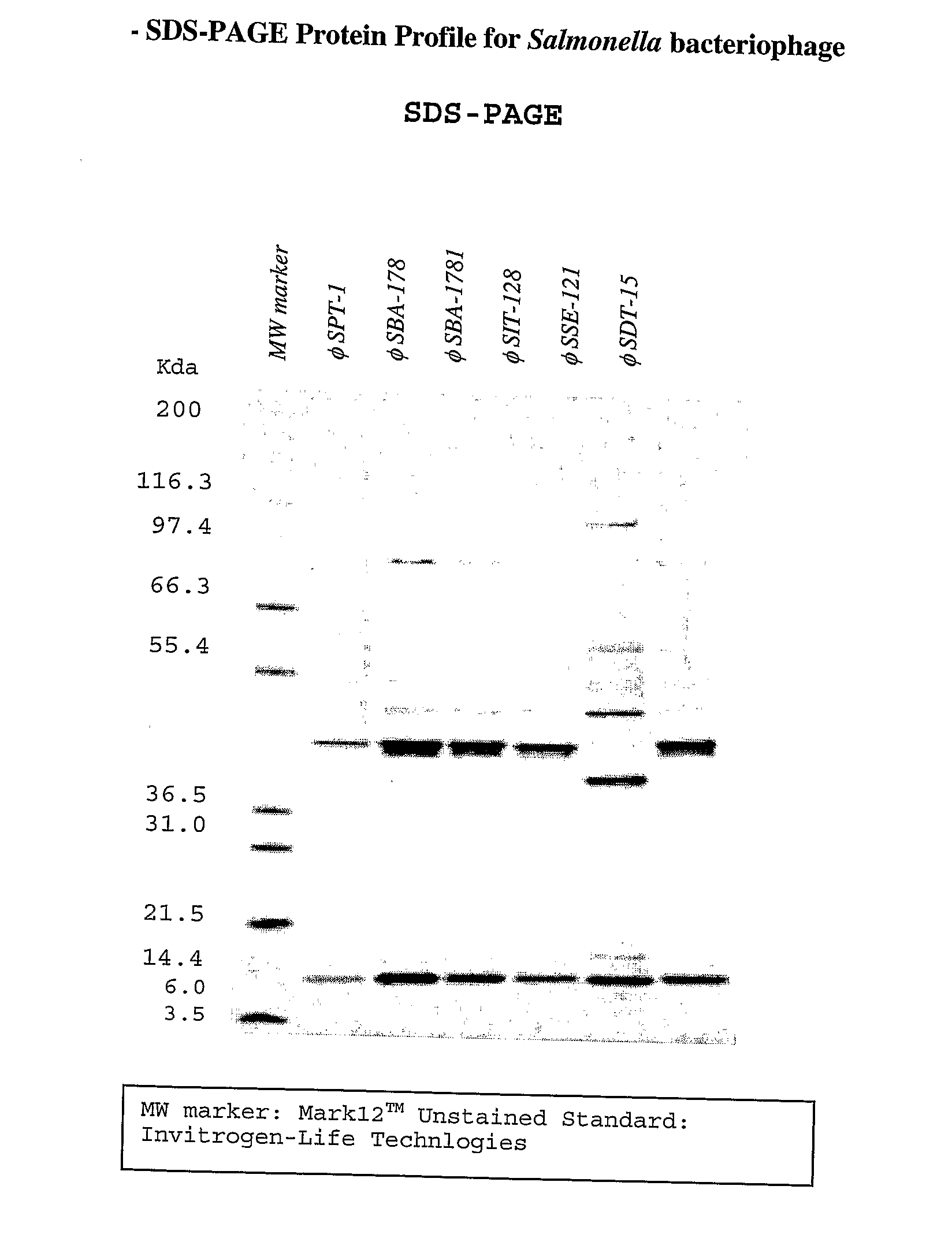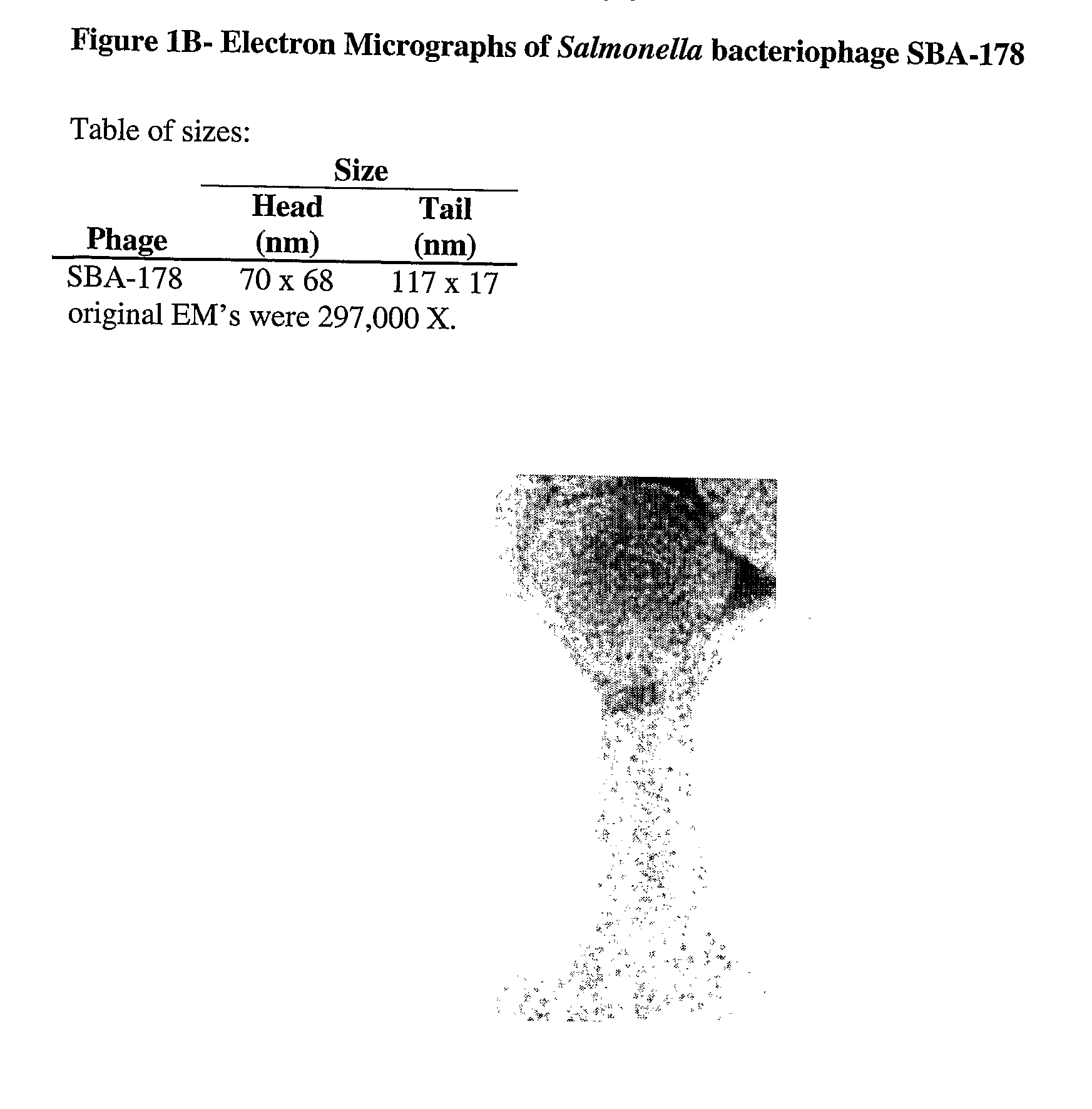Novel Salmonella Bacteriophage and Uses Thereof
a bacteriophage and salmonella technology, applied in the field of new salmonella bacteriophage, can solve the problems of variable early studies to evaluate bacteriophage as antimicrobial agent, bacteriophage were not useful as antimicrobial agent, and the therapeutic use of phage gradually fell out of favor
- Summary
- Abstract
- Description
- Claims
- Application Information
AI Technical Summary
Benefits of technology
Problems solved by technology
Method used
Image
Examples
example 1
Salmonella Bacteriophage Isolation
[0079]Salmonella bacteriophage were isolated from Baltimore Inner Harbor waters (isolates SIT-128; SSE-121) and Baltimore sewage effluent (isolates SPT-1; SBA-178; SDT-15; SBA-1781) using lysis of Salmonella to form plaques in bacterial lawns as a means of detecting the presence of bacteriophage having lytic specificity for Salmonella. Plaques are harvested, diluted, and re-plated on bacterial lawns through a process of serial enrichment until a single bacteriophage species, or monophage, results as determined by a stable restriction fragment length profile of the bacteriophage DNA. The isolates obtained using the technique recited supra may be cultured using the techniques as set forth herein. Salmonella bacteriophage was deposited with the ATCC, receiving ATCC Deposit Accession Nos. PTA-5281, PTA-5284, PTA-5282, PTA-5285, PTA-5283 and PTA-5280.
[0080]PFU concentration of the Salmonella bacteriophage may be determined using techniques known in the a...
example 2
Production of Salmonella Bacteriophale Lysate in Liquid Culture
Salmonella Bacteriophage Culturing
[0081]Single aliquots of Salmonella, stored in 70% LB broth / 30% glycerol medium, were revived from a −80° C. freezer. The Salmonella culture was allowed to thaw at room temperature for 15-30 min., followed by brief vortexing. 10 ml of Salmonella was inoculated into 35 ml of LB-broth medium, and cultured at 30° C. at 150 rpm over-night on a rotary shaker. The resulting O.D.600 of the culture was approximately 0.3-0.4.
[0082]10 ml of Salmonella was inoculated into 100 ml of LB-broth medium, and cultured at 30° C. at 150 rpm for approximately 2-2.5 hours, until the OD600 reaches 0.1. To this culture was added a total of approximately 109 PFU of Salmonella bacteriophage. (PFU of the Salmonella bacteriophage was confirmed before-hand).
[0083]The mixture was then transferred to a 2 L flask containing 1.0 L of M9 medium supplemented with 20% glucose, 1 M MgSO4, and 1 M CaCl2. The mixture was cult...
example 3
Alternative Production of Salmonella Bacteriophage Lysate in Liquid Culture
[0092]Shake flask batches of each phage were carried out in 2-L flasks. Salmonella enterica strains were grown in LB broth overnight at 37° C., subcultured and grown to an OD600 of 0.2-0.3. Growth was monitored spectrophotometrically until lysis occurred and phage harvested by vacuum filtration (Stericup, Millipore). Triplicate batches of each phage were concentrated separately and buffer exchanged with PBS by tangential-flow filtration in a Pellicon 2 Mini Cassette using a 50 kDa filter (Millipore). High titer master and working stocks of each monophage were made in liquid cultures. Cultures of the appropriate Salmonella enterica host strain were grown in LB broth to an OD600 of 0.2-0.3. Growth was monitored spectrophotometrically, following lysis, phage were sterile filtered (0.22 μm Stericup, Millipore) and treated with DNase I and RNase A to a final concentration of 1 μg / ml for 30 min at room temperature....
PUM
| Property | Measurement | Unit |
|---|---|---|
| Length | aaaaa | aaaaa |
| Fluorescence | aaaaa | aaaaa |
| Chemiluminescence | aaaaa | aaaaa |
Abstract
Description
Claims
Application Information
 Login to View More
Login to View More - R&D
- Intellectual Property
- Life Sciences
- Materials
- Tech Scout
- Unparalleled Data Quality
- Higher Quality Content
- 60% Fewer Hallucinations
Browse by: Latest US Patents, China's latest patents, Technical Efficacy Thesaurus, Application Domain, Technology Topic, Popular Technical Reports.
© 2025 PatSnap. All rights reserved.Legal|Privacy policy|Modern Slavery Act Transparency Statement|Sitemap|About US| Contact US: help@patsnap.com



